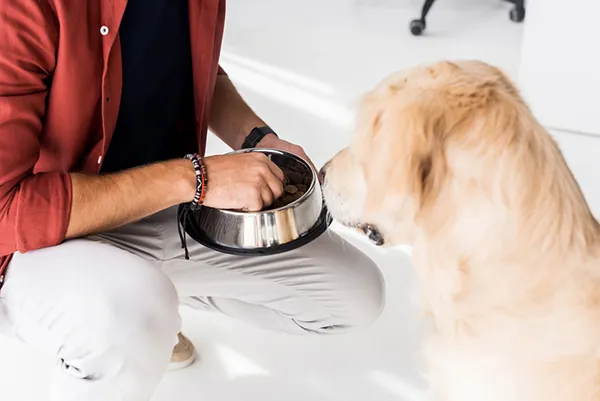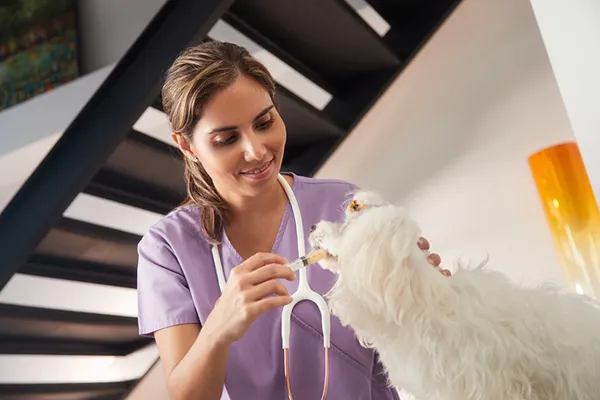It can be distressing for any dog owner when their beloved canine companion refuses to eat. Just like humans, a dog’s appetite can wane when they’re feeling under the weather, making them turn away from even their favorite meals. While a single missed meal might not be cause for immediate alarm, a prolonged refusal to eat indicates an underlying issue that requires attention. Understanding why your dog isn’t eating and knowing what safe, appetizing options to offer can be crucial for their recovery and well-being. This guide will walk you through common reasons for appetite loss, when to seek veterinary help, and practical strategies on What To Feed A Dog Who Will Not Eat, ensuring they get the nourishment they need.
Why Your Dog Might Be Refusing Food
A dog’s loss of appetite, medically termed anorexia, can stem from various causes, ranging from minor upsets to more serious conditions. It’s essential to observe your dog closely for any accompanying symptoms. The most common reasons a dog might lose their appetite include:
- Illness and Infection: Many illnesses, even mild ones, can cause nausea or general discomfort, leading to a loss of interest in food. Infections, whether bacterial or viral, can also significantly impact appetite.
- Disease: Chronic diseases affecting organs like the kidneys, liver, or pancreas can manifest as a persistent lack of appetite.
- Recovery from Surgery: Anesthesia, pain, and the stress of surgery can all temporarily suppress a dog’s desire to eat.
- Mourning a Death: Dogs form strong bonds and can experience grief, leading to behavioral changes including a refusal to eat.
- Aging: Senior dogs may experience a diminished sense of smell or taste, dental problems, or underlying health issues that make eating less appealing.
- Stress and Anxiety: Changes in environment, new pets, separation anxiety, or loud noises can cause stress, which can suppress appetite.
While occasionally skipping a meal might be normal, consistent food refusal warrants a closer look.
When to Seek Veterinary Care
If your dog’s refusal to eat is accompanied by other concerning symptoms, or if it persists for more than 24-48 hours, it’s crucial to contact your veterinarian immediately. Early diagnosis and treatment can prevent the condition from worsening. You should contact your veterinarian as soon as possible for an examination and potential testing if your dog exhibits any of the following symptoms in conjunction with a loss of appetite:
- Vomiting
- Lethargy or unusual weakness
- Significant weight loss
- Diarrhea
- Gagging or difficulty swallowing
- Wheezing or difficulty breathing
- Persistent coughing
These symptoms could indicate a serious underlying health issue that requires professional medical intervention.
Effective Methods to Encourage Eating
When your dog won’t eat, finding the right approach can be a process of trial and error. What works for one dog might not work for another, so be patient and try different methods.
Give Your Dog Some Time
If your dog turns down a meal, the first step is often to simply allow them some time. Healthy dogs can typically go for a couple of days without food, provided they are still drinking water. It’s normal for a dog to occasionally refuse a meal if they’re not particularly hungry. You might consider leaving their food out for a short period, allowing them to graze if their appetite returns. However, always ensure they are drinking plenty of water, as dehydration can quickly become a serious concern.
Offer Special Treats
If your dog is feeling unwell, trying to entice them with foods they don’t normally get can sometimes work wonders. Human foods like plain, cooked chicken or even meat-based baby food can be highly appealing to a sick dog. Start with a small amount to see if they show interest. If successful, you can try mixing a bit of this “treat” with their regular dry food to encourage them to eat their normal diet. However, moderation is key to avoid upsetting their stomach further, and always ensure the human food is safe for dogs. For more information on what types of human foods are generally safe, you can read about what human foods can dogs safely eat.
Change Dry Food Brands or Add Wet Food
If dry kibble isn’t appealing, consider a different brand. Sometimes, a change in flavor or texture can stimulate a dog’s appetite. Many pet stores offer sample packs, allowing you to test various options. Alternatively, mixing in some wet dog food can significantly increase palatability, as wet food is often more aromatic and texturally appealing than dry kibble.
Heat Up Your Dog’s Food
Warming your dog’s food, whether it’s dry kibble or wet food, can enhance its smell and taste. Sick dogs often have a dulled sense of smell and taste, which can make their regular food seem unappetizing. A warmed meal releases more aroma, making it more fragrant and enticing, which can encourage your dog to take that crucial first bite and continue eating.
Add Broth to Your Dog’s Food
Similar to heating food, adding warm, unseasoned bone or chicken broth to your dog’s meal can make it more palatable and add extra flavor. Broth can be particularly appealing if your dog has grown tired of their current food’s taste or if they need extra hydration. It’s a mild, nutritious addition that can stimulate a suppressed appetite.
Hand-Feed Your Dog
Sometimes, a sick dog might need a little extra comfort and encouragement. Trying to hand-feed individual pieces of their food can be a gentle way to re-establish their interest in eating. This personal interaction can be very reassuring to a dog who isn’t feeling well, and it might just be enough to get them to start eating from their bowl again after a few hand-fed bites.
 Owner gently hand-feeding their dog kibble from their palm
Owner gently hand-feeding their dog kibble from their palm
Read the Instructions on Any Medication
Certain medications, especially antibiotics, can cause a reduction in appetite as a side effect. If your dog is currently on medication, carefully read the instructions. It might be beneficial to wait at least fifteen minutes after administering medicine before offering food. This allows the medication to settle in their stomach, potentially reducing the chance of an upset stomach or nausea when food is introduced.
Let Your Dog Eat Grass (with caution)
If your dog refuses their normal food but shows interest in eating grass, you might allow them to do so in moderation. Eating grass can sometimes induce vomiting, which, if your dog is feeling ill due to an upset stomach, might actually provide relief by expelling whatever is causing discomfort. However, ensure your dog remains well-hydrated. If your dog vomits more than twice, or consistently eats grass and vomits, it’s a clear signal to consult your veterinarian.
 Two brown dachshunds curiously eating green grass outdoors
Two brown dachshunds curiously eating green grass outdoors
Visit the Vet
If home remedies aren’t working, taking your dog to the vet is always a good idea when they are sick and won’t eat. Your veterinarian can conduct a thorough examination, diagnose the underlying cause of their appetite loss, and recommend appropriate treatment. They can also prescribe medications, such as anti-nausea drugs or appetite stimulants, to help your dog feel better and encourage them to eat. For a comprehensive overview of general dog nutrition, consider exploring what are things dogs can eat.
Stimulate Your Dog’s Appetite Medicinally
If your dog has refused food for an extended period, or if they have a chronic health condition that suppresses their appetite, your vet might prescribe an appetite stimulant. These medications can work in different ways, either by reducing nausea or by mimicking the hormones that naturally trigger hunger. This approach requires a proper veterinary diagnosis to ensure the correct stimulant is chosen for your dog’s specific condition.
Use a Syringe (Under Veterinary Guidance)
Force-feeding via a syringe is a drastic measure and should only be considered if other methods have failed and always under the strict guidance of your veterinarian. If your dog hasn’t eaten in two days, a vet might recommend using a syringe to administer liquids like broth or watered-down wet food. If medication is needed, a syringe can also be used for administration. It’s crucial to learn the correct technique from your vet to prevent aspiration pneumonia or other negative health effects.
 Veterinary technician carefully force-feeding a dog using a syringe
Veterinary technician carefully force-feeding a dog using a syringe
Recommended Foods for a Sick Dog
When your dog is ill and not eating, certain bland, easily digestible foods can be more appealing and gentler on an upset stomach than their regular diet.
Wet Food
If your dog typically eats dry kibble, introducing wet food can be an exciting and hydrating change. Its strong aroma and soft texture are often more appealing to sick dogs, and the higher water content contributes to their hydration.
Baby Food
Plain, meat-based baby food (chicken, lamb, or turkey) without onion or garlic powder can be an easy-to-eat and nutritious option. Its smooth consistency is gentle on a sensitive stomach.
Bone Broth
Bone broth is mild, highly palatable, and packed with nutrients. It’s excellent for dogs with suppressed appetites or upset stomachs, providing essential nourishment without being heavy.
Chicken Broth
Similar to bone broth, unseasoned chicken broth can be a comforting and tasty option. It’s easy on the stomach and provides crucial hydration, especially if the loss of appetite is due to a gastrointestinal upset.
Shredded Chicken
Plain, boiled, unseasoned shredded chicken is often irresistible to dogs. It’s easy to digest and a great incentive for a sick dog to eat. Ensure it’s cut into small, manageable pieces.
Chicken and Rice
A classic bland diet, plain boiled chicken and white rice are gentle on an upset stomach. These ingredients are commonly found in commercial dog foods for their digestibility. Ensure the chicken is thoroughly cooked and unseasoned, and the rice is white for easier digestion.
Pumpkin
Pure canned pumpkin (not pumpkin pie filling, which contains sugar and spices) is excellent for digestive health. High in fiber and rich in vitamins A, C, iron, and magnesium, it can help soothe an upset stomach. Offer a few tablespoons mixed with other bland foods.
The Importance of Hydration When Your Dog Won’t Eat
While food intake is important, water intake is arguably even more critical for a sick dog. Dogs can survive for several days without food, but their tolerance for dehydration is much lower; they typically cannot go more than three days without water. Dehydration can quickly worsen a dog’s condition, making it vital to encourage fluid consumption. It’s important never to force your dog to drink, as this can lead to aspiration pneumonia. If your dog hasn’t eaten or drunk for 48 hours, seek immediate veterinary attention.
How to Encourage Water Intake
If your dog is reluctant to drink water, try these tricks:
- Offer ice cubes to lick.
- Present water on your fingers.
- Ask your vet about offering Pedialyte for electrolyte replenishment.
- Add ice to their water bowl, which can make it more appealing.
Signs of Dehydration
Watch for these common symptoms of dehydration:
- Loss of appetite (can be a symptom of dehydration itself)
- Excessive panting
- Lethargy or weakness
- Loss of skin elasticity (skin tenting when gently pulled up)
- Dry, sticky gums
- Dry nose
- Sunken or dry-looking eyes
If you observe any signs of dehydration, seek immediate veterinary attention. Your vet can provide subcutaneous fluids to rehydrate your dog while addressing the underlying cause of their sickness.
Foods to Avoid Feeding a Sick Dog
When your dog is unwell, it’s crucial to be mindful of what you offer. Avoid anything too rich or fatty, as these can exacerbate gastrointestinal issues. If your dog is already sick, ensure they haven’t had access to any of the following potentially harmful foods:
| Don’t Feed Your Dog: | Because… |
|---|---|
| Xylitol | This artificial sweetener can cause a rapid drop in blood sugar and liver failure. |
| Avocado | Avocado seeds can cause an intestinal obstruction, and the persin in avocado can cause illness in some animals. |
| Grapes or Raisins | Highly toxic and can cause acute kidney failure, even in small amounts. |
| Caffeine | Found in coffee, tea, and energy drinks, caffeine can be fatal, causing heart palpitations, tremors, and seizures. |
| Onions or Garlic | These allium vegetables can cause red blood cell damage, leading to anemia or poisoning. |
| Alcohol | Any amount of alcohol can cause vomiting, diarrhea, central nervous system depression, breathing problems, and potentially death. |
| Milk or Other Dairy | Many dogs are lactose intolerant, leading to diarrhea and other digestive problems. |
| Human Medication | Over-the-counter or prescription human medications can be toxic or fatal to dogs. |
| Chocolate | Contains theobromine, which can cause vomiting, diarrhea, seizures, and potentially death, depending on the type and amount. |
| Sugar | Sugary foods can lead to weight gain, dental issues, and diabetes in dogs. |
| Macadamia Nuts | Can cause weakness, vomiting, tremors, and hyperthermia, though the exact toxic mechanism is unknown. |
| Raw Eggs | Risk of salmonella or E.coli contamination, and avidin in raw egg whites can interfere with biotin absorption. |
| Raw Fish or Meat | Can contain parasites, bacteria, and other pathogens that cause illness. |
| Uncooked Yeast Dough | Can rise in the stomach, causing bloating and pain, and produce alcohol, leading to alcohol poisoning. |
| Fat Trimmings | High-fat foods can cause pancreatitis, a painful and potentially severe inflammation of the pancreas. |
| Spices, Baking Powder, or Baking Soda | Many common kitchen ingredients can be toxic to dogs or upset their digestive system. |
| Bones | Cooked bones can splinter and cause choking or internal damage. Raw bones carry a risk of bacterial contamination. |
| Fruits with Seeds or Pits | Seeds and pits can pose a choking hazard, cause intestinal obstruction, or contain toxic compounds. Be especially careful with what fruits should dogs not eat that contain pits. |
| Salt | Too much salt can lead to sodium ion poisoning, causing vomiting, diarrhea, tremors, and seizures, and can exacerbate dehydration. Similarly, be aware of what vegetables can dogs not eat when preparing food for your dog. |
Frequently Asked Questions About Dogs Refusing Food
When Shouldn’t I Feed My Sick Dog?
If your dog has been vomiting or experiencing diarrhea, it’s generally best to withhold food for at least twelve hours after the last episode. Feeding too soon can irritate their stomach further and prolong the upset. Ensure they have access to fresh water. If vomiting or diarrhea persists for more than two days, contact your vet.
How Much Should I Feed My Sick Dog?
The amount of food to offer a sick dog depends on their size, condition, and the type of illness. It’s always best to consult with your veterinarian for specific dietary recommendations. In general, start with small, frequent meals rather than large portions. Allow your dog to guide you; if they eat some and then refuse, don’t force them. Wait a while before offering food again.
 Golden retriever dog resting comfortably on a soft bed
Golden retriever dog resting comfortably on a soft bed
Do Sick Dogs Lose Their Sense of Smell?
While illness itself doesn’t necessarily cause a loss of smell, various factors can affect a dog’s most powerful sense. Allergies, nasal infections, advanced age, or a dry nose can all diminish a dog’s ability to smell, which can impact their appetite. This is why warming food to enhance its aroma can be effective.
What Else Can I Do to Help My Dog?
Beyond food and water, ensuring your dog’s comfort is paramount. Provide a quiet, comfortable bed in a peaceful area for them to rest. If they are up to it, short, gentle walks can sometimes stimulate their appetite and provide a welcome distraction. It’s also important for you to remain calm; dogs are highly attuned to human emotions and can become more stressed if they perceive you are anxious.
How Long Can a Dog Go Without Food?
While dogs can typically go three to five days without food, this is not ideal, and you should not let it get to this point. If your dog has not eaten for two full days, it is highly recommended to contact a veterinarian if you haven’t already. Hydration is even more critical; dogs cannot survive long without water.
Should I Feed My Dog After They Throw Up?
It is generally best to withhold food from your dog for a few hours (e.g., 6-12 hours) after they vomit. This allows their digestive system to rest and helps you observe if the vomiting continues or if other symptoms develop. Always ensure fresh water is available, and seek veterinary advice if vomiting is persistent or severe.
Should You Force-Feed a Sick Dog?
Force-feeding a sick dog, especially with a syringe, should only be considered as a last resort and strictly under the guidance and demonstration of a veterinarian. It is typically recommended only if your dog has not eaten for more than 48 hours and a vet has determined it’s safe and necessary. Improper force-feeding can lead to aspiration or further stress for your pet.
What to Do After 48 Hours of Food Refusal
If your dog is still refusing to eat after 48 hours, it’s a clear indication that immediate veterinary care is necessary. Prolonged anorexia can lead to serious health complications, including dehydration, malnutrition, and a worsening of any underlying conditions. An expert team of veterinary professionals can thoroughly examine, diagnose, and treat your furry friend, providing the necessary medical intervention to help them recover and regain their appetite before their condition escalates.
